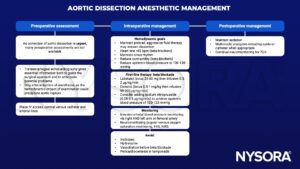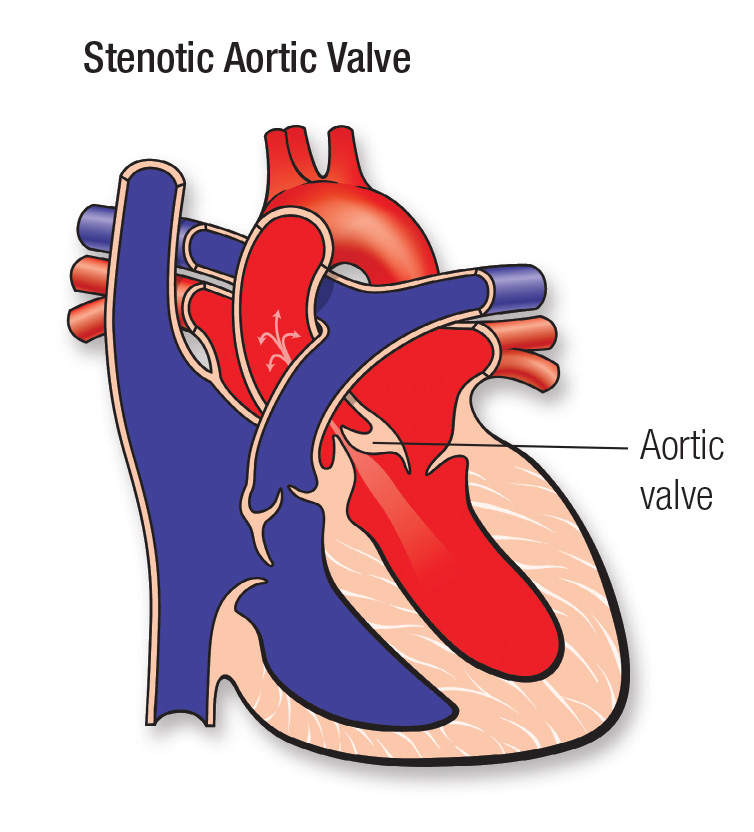Learning objectives
- Define and classify aortic dissection
- Describe the risk factors for aortic dissection
- Diagnose aortic dissection
- Manage patients with aortic dissection
Definition & mechanisms
- Life-threatening emergency
- Most common type of acute aortic syndrome
- Occurs when a tear in the aortic intima allows blood to dissect into the wall of the aorta
- Can result from abnormalities in underlying tissue structure (Marfan syndrome, Loeys-Dietz syndrome)
- Can also occur in previously asymptomatic patients with no known genetic aortopathy
- Often associated with an increase in physical activity or stress, leading to acute hypertension
Classification
There are several classification systems for aortic dissection:
| DeBakey | Type I | Tear in the ascending portion; involves all portions of the thoracic aorta |
| Type II | Tear in the ascending aorta; involves the ascending aorta only, stopping before the innominate artery |
|
| Type III | Tear located in the descending segment; almost always involves the descending thoracic aorta only, starting distal to the left subclavian artery; can propagate proximally into the arch |
|
| Stanford | Type A | All dissections involving the ascending aorta irrespective of the site of tear |
| Type B | All dissections that do not involve the ascending aorta |
Risk factors
| Lifestyle factors | Long-term arterial hypertension | |
| Smoking | ||
| Dyslipidemia | ||
| Cocaine, crack cocaine, or amphetamine use | ||
| Connective tissue disorders | Marfan’s syndrome | |
| Loeys-Dietz’s syndrome | ||
| Ehlers-Danlos syndrome | ||
| Turner’s syndrome | ||
| Hereditary vascular disease | Bicuspid aortic valve | |
| Coarctation of the aorta | ||
| Vascular inflammation | Autoimmune disorders | Giant-cell arteritis |
| Takayasu’s arteritis | ||
| BehÇet’s disease |
||
| Ormond’s disease | ||
| Infection | Syphilis | |
| Tuberculosis | ||
| Deceleration trauma | Car accident | |
| Iatrogenic factors | Catheter or instrument intervention | |
| Valvular or aortic surgery | Side-clamping, cross-clamping, or aortotomy | |
| Graft anastomosis | ||
| Patch aortoplasty |
Diagnosis
- Imaging
- CT
- The triple rule-out protocol is the one-stop CT examination for chest pain designed to differentiate acute coronary syndrome, pulmonary embolism, and acute aortic dissection
- Transthoracic echocardiography (TTE)
- Transesophageal echocardiography (TEE)
- More complete imaging of the aorta than TTE
- MRI
- Can combine anatomical and functional information in one examination and provide a comprehensive evaluation of aortic dissection
- CT
- Biomarkers
- D-dimer and fibrin degradation products
- Smooth muscle myosin heavy chain
- Matrix metalloproteinase-9
- Elastin degradation products
- Calponin
- Transforming growth factor-beta (TGFβ)
Management

Suggested reading
- Agarwal S, Kendall J, Quarterman C. Perioperative management of thoracic and thoracoabdominal aneurysms. BJA Educ. 2019;19(4):119-125.
- Gregory SH, Yalamuri SM, Bishawi M, Swaminathan M. The Perioperative Management of Ascending Aortic Dissection. Anesth Analg. 2018;127(6):1302-1313.
- Nienaber CA, Clough RE. Management of acute aortic dissection. Lancet. 2015;385(9970):800-811. doi:10.1016/S0140-6736(14)61005-9
We would love to hear from you. If you should detect any errors, email us customerservice@nysora.com







